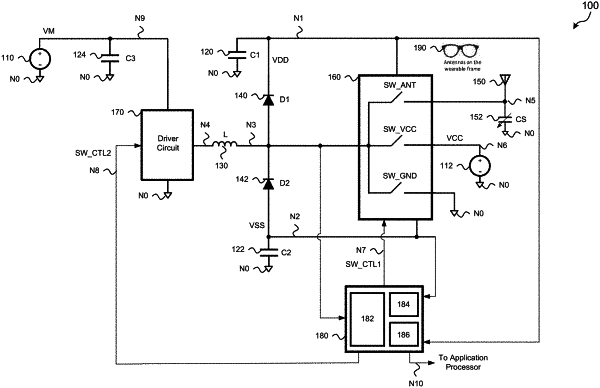| CPC G06F 3/011 (2013.01) [A61B 5/16 (2013.01); G01D 5/24 (2013.01); G06F 1/163 (2013.01); G06F 3/012 (2013.01); G06F 3/015 (2013.01); G06V 40/16 (2022.01); G06V 40/174 (2022.01); G06V 40/176 (2022.01); H02J 7/0063 (2013.01)] | 20 Claims |

|
1. A battery operated device to generate dual supply voltages and sense facial movements of a user by time-multiplexed operation, the device comprising:
a first capacitor circuit (120) coupled between a first node (N1) and a circuit ground (N0), wherein the first node (N1) corresponds to a first of the dual supply voltages (VDD);
a second capacitor circuit (122) coupled between a second node (N2) and the circuit ground (N0), wherein the second node (N2) corresponds to a second of the dual supply voltages (VSS);
an inductor circuit (130) coupled between a third node (N3) and a fourth node (N4);
a first diode circuit (140) coupled between the third node (N3) and the first node (N1);
a second diode circuit (142) coupled between the second node (N2) and the third node (N3);
an antenna (150) coupled to a fifth node (N5), wherein the antenna (150) has a characteristic capacitance that corresponds to a sense capacitor (152) with a capacitance value that varies responsive to the facial movements of the user;
a multiplexer (160) that includes an input coupled to the third node (N3), a first output coupled to the circuit ground (N0), a second output coupled to a DC source at a sixth node (N6), and a third output coupled to an antenna (150) at the fifth node (N5), wherein the multiplexer (160) is configured to couple the input to one of the first output, the second output and the third output responsive to a first control signal (SW_CTL1); and
a driver circuit (170) that includes a first power terminal coupled to the battery, a second power terminal coupled to the circuit ground, an output coupled to the fourth node (N4), wherein the driver circuit (170) and the multiplexer circuit (160) are configured via the first and second control signals (SW_CTL1, SWCTL2) to selectively: charge the inductor circuit (130) to generate the dual supply voltages, and drive the inductor circuit (130) with the antenna (150) as a resonance circuit to generate a resonance that varies responsive to facial movement of the user.
|